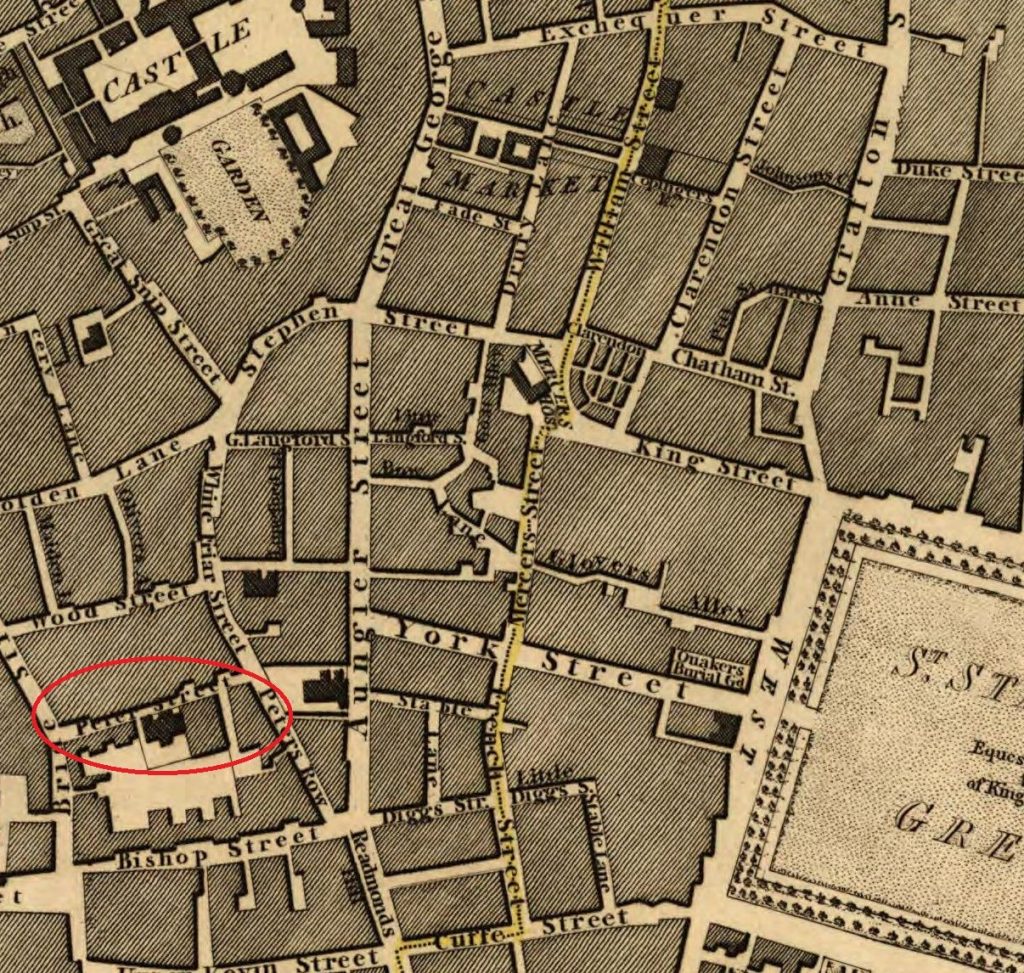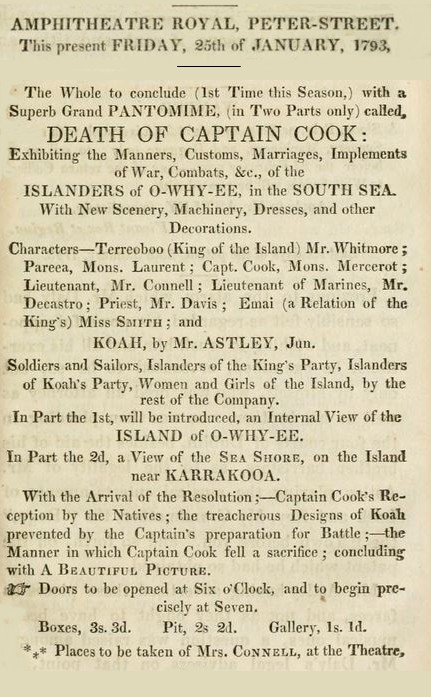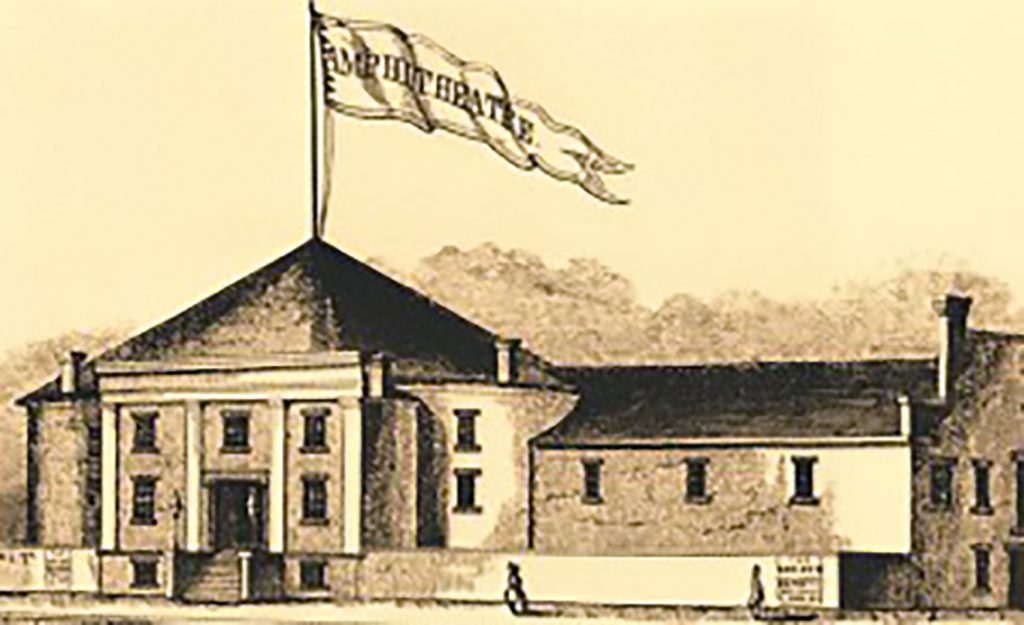Astley’s equestrian drama
The Death of Captain Cook, Dublin 1789
…the grandest spectacle ever exhibited in this metropolis 1
The grand equestrian drama The Death of Captain Cook enthralled audiences in Dublin throughout the winter of 1789-90. Astley was keen to extend the popularity of his new entertainment and looked for new venues and audiences for his equestrian shows. In Ireland, his military connections helped to establish a theatre in Peter Street in the centre of Dublin. The influential Sir Capel Molyneux assisted him to obtain a patent in 1788 and the amphitheatre opened the following year.

A map of the city of Dublin in 1797, showing the location of Astley’s amphitheatre in Peter Street, and its proximity to Dublin Castle and St. Stephen’s Green. 2
Although the circus was regarded as inferior to serious theatre, it nonetheless had achieved a degree of respectability by 1788, and the colonial administration in Ireland viewed Astley’s performances as both respectable and patriotic. This may have been a significant factor in gaining approval for his license—the government was eager to establish a “well regulated theatre” in Dublin. Due to the perceived rowdiness and threat of insurrection, all ‘lower order’ playhouses had been closed by the Irish Stage Act of 1786. The only remaining theatre had proven itself to be “wretched, filthy and degraded” 3 with “ a poorly paid troop and miserable scenery.” 4 According to one of Astley’s performers, “the whole of the people in the city”5, including the gentry and nobility were determined to have a reputable theatre, and this opened the way for the equestrian amphitheatre in Peter Street.
The actor, Jacob Decastro, later recalled:
Mr Astley being now without opposition, he was completely successful; so much so, that in the historical production of Captain Cook, his house was crowded to that degree, that the audience occupied the principal part of the stage…6
A review in the Hibernian Journal described the staging of The Death of Captain Cook in glowing terms. Astley’s son had played the role of Koah, the Hawaiian prince, and presumably Astley himself took the role of Cook—Astley and Cook had a similar stature, both being remarkably tall.
The pantomime entertainment… was the grandest spectacle ever exhibited in this metropolis; the music is most pathetic and expressive – the scenery, decoration and dress truly picturesque, and the character well supported; but inimitable, indeed, is the action of young Astley in the character of Koah; nor is it more than justice to say, that we never witnessed such theatrical excellence before – every beholder was lost in admiration, and we cannot cease to wonder how he could obtain such just notions of the people who inhabited the remote regions in the South Seas. 7
Despite the rave review, not everyone in the audience was appreciative of Astley’s efforts and some of the problems which had caused the closure of earlier playhouses arose again. It was customary for the “low and ragged company” 9 in Irish audiences to actively express their opinions, and some of Astley’s performances were disrupted by taunts, remarks, groans, and claps. The revolutionary group, the United Irishmen, objected to the overtly patriotic items in the show – not The Death of Cook particularly, but Astley’s billing as the English Hussar and the notion of British superiority inherent in some of the acts. However, the season was regarded as hugely successful and the disturbances in no way deterred Astley from further visits to Dublin.
After two months, Astley was ready to move on and the next venue for his tour was announced:
Astley leaves this city on the 4th of February next, in order to open the Theatre Royal in Liverpool. His success here this season, has been very great; his entertainments in general have been well received, and much admired. – We have had the pantomime of the Death of Captain Cook, and I assure you in a style exceedingly interesting and novel. His theatre in Peter Street is pretty and neat, and the scenery and machinery would do credit to the first opera in Europe. 10
In future years, Astley returned to Ireland regularly and the equestrian version of The Death of Captain Cook was maintained in the repertoire.

Playbill for Astley’s performance of the “superb grand pantomime” the Death of Captain Cook at Astley’s Amphitheatre, Peter Street, Dublin in 1793. 11
References
1 Hibernian Journal, 16 December 1789, cited in Reece, B. (1997). Irish Anticipations of Botany Bay. Eighteenth-Century Ireland / Iris an Dá Chultúr, 12, 116-136. Retrieved from http://www.jstor.org/stable/30071389
2 A plan of the city of Dublin 1797. https://www.loc.gov/item/2004626017/ and https://commons.wikimedia.org/wiki/File:1797-map-of-Dublin.jpg
3 Decastro, J., & Humphreys, R. (1824). The memoirs of J. Decastro, comedian. In the course of them will be given anecdotes of various eminently distinguished characters … Amongst others are Dr. Johnson, Garrick, Foote, … accompanied by an analysis of the life of the late Philip Astley. Also an accompanying History of the Royal circus, now the Surrey theatre; and an historical sketch of Sadler’s Wells. Likewise scarce theatrical advertisements, from Garrick’s first attempt in Goodman’s-Fields … To which will be added The origin of poetry; A chapter on Bent’s, & c. https://archive.org/details/memoirsofjdecast00deca/page/n5/mode/2up
4 Burke, H. (2006). Jacobin Revolutionary Theatre and the Early Circus: Astleys Dublin Amphitheatre in the 1790s. Theatre Research International, 31(1), 1-16. doi:10.1017/S0307883305001847
5 Decastro & Humphreys, 1824. p.52
6 Decastro & Humphreys, 1824. p.53
7 Hibernian Journal, 16 December 1789, cited in Reece, B. (1997). Irish Anticipations of Botany Bay. Eighteenth-Century Ireland / Iris an Dá Chultúr, 12, 116-136. Retrieved from http://www.jstor.org/stable/30071389.
8 Astley’s Amphitheatre Royal in Dublin (c.1790) http://www.circopedia.org/Astley%27s_Amphitheatre.
9 Dibdin Memoirs of Charles Dibdin the Younger, cited in Burke (p. 7)
10 “News.” Gazetteer and New Daily Advertiser, 27 Jan. 1790. Seventeenth and Eighteenth Century Burney Newspapers Collection, https://link.gale.com/apps/doc/Z2000404994/GDCS?u=bccl&sid=GDCS&xid=e3cb1e42. Accessed 11 Feb. 2020.
11 Decastro & Humphreys, 1824. p.55
______________________________________________________________
This resource was created on the lands of the Gubbi Gubbi people.
We pay our respects to their elders past and present.
______________________________________________________________
Header credits:
1. Portrait of Captain Cook by Nathaniel Dance-Holland [Public domain]
2. A jig on board by Cruikshank. Courtesy of The Lewis Walpole Library, Yale University
3. View of the South Seas by John Cleveley the Younger [Public domain]
______________________________________________________________
The information on this website www.historicaldance.au may be copied for personal use only, and must be acknowledged as from this website. It may not be reproduced for publication without prior permission from Dr Heather Blasdale Clarke.



